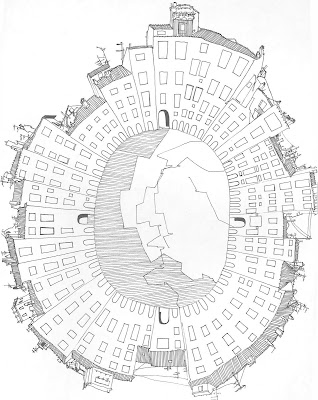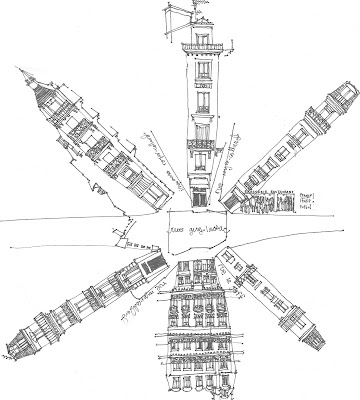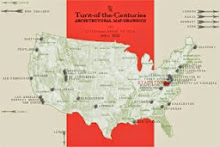I'm feeding my curiosity about John Taylor Arms, piqued after visiting the show at the National Gallery. A friend gave me a book on his work and career for my birthday: John Taylor Arms: Plates of Perfect Beauty, Jennifer Saville.
Arms worked as an architect, even built his own firm with a partner, until about 1916 when drawing and etching outpaced his desire to design and build. 'Out of My Window', above, drawn from his New York architectural firm office, is a seed of that desire which expanded to a prolific and highly respectable career as an etcher and advocate of the graphic arts.
 An Old Courtyard, Italy, 1920, John Taylor Arms
An Old Courtyard, Italy, 1920, John Taylor Arms  Castles in the Air, Lithograph, 1921, John Taylor Arms, "La Giralda", Seville, 1924
Castles in the Air, Lithograph, 1921, John Taylor Arms, "La Giralda", Seville, 1924 Mont Saint-Michel, 1926, John Taylor Arms
Mont Saint-Michel, 1926, John Taylor ArmsI love the perspective of this work which reminds me of seeing hill towns while flying over Italy and France and drawing villages nestled onto the steep rocky Adriatic coast from the hiking trail above them. It seems a precious thing to see a town in its entirety from such a vantage point, the town offered up to view by the obliging landscape, and a sketching seat just right for this encapsulated view.
 Study in Stone, Cathedral of Orense, John Taylor Arms, 1933
Study in Stone, Cathedral of Orense, John Taylor Arms, 1933A progression toward greater architectural detail and meticulous lines is evident in Arms' European works and seems to reach an apogee in Venice.
 (drawing) The Enchanted Doorway, Venezia, 1930, John Taylor Arms (etching)
(drawing) The Enchanted Doorway, Venezia, 1930, John Taylor Arms (etching) Venetian Filigree, 1931, John Taylor Arms
Venetian Filigree, 1931, John Taylor Arms La Bella Venezia, 1930, John Taylor Arms
La Bella Venezia, 1930, John Taylor ArmsThe waterscape reminds me of 'la bella' Venezia. Il Canal Grande La Piazza S. Marco.1928
As an ardent advocate of etching as an art, Arms took his art to the people in a series of over 150 Demonstrations where he etched and printed before a live audience on a portable press in libraries, museums, before TV cameras, the New York World's Fair, a Manhattan store window. Most demonstration prints, like 'The Grolier Club' above were created in about 2 hours, though he often spent over 1,000 hours on a single print in his main body of work.
I'd like to ask him how the transition from practicing architect to artist evolved, his thoughts on the practice of architecture, I'd like to watch him draw on-site amid all of the distractions and discomforts then translate that drawing onto a plate with painstaking precision. If you could have a conversation with a dead, great someone...
Some of his thoughts give a glimpse into those wonderings, as quoted in John Taylor Arms: Plates of Perfect Beauty, Jennifer Saville:
On the power of Gothic Architecture, They were born of an age when man's need for the expression of his spiritual ideals drove him to heights of architectural conception to which he has never since attained. The devotion and aspiration that went into their construction is echoed in every line and detail and mass. From the architects who planned them down to the humblest stonecutter who carved the most inconcpicuous of their mouldings, we feel a spiritual and imaginative fervor which has no parallel in the history of building...All were animated by the same motive -- the sense of spiritual dedication which counted time as naught so long as the end was attained.
On and the quest for spiritual and technical, I like to think of a work of art as having two principal aspects, namely the spiritual and the technical...Between the two there is no comparison in importance. It is the thought which a man has to give the world that makes for him his place in the minds of posterity, not the language....Better the true artist who is a clumsy technician than the most accomplished virtuoso who has nothing to say.
It is true that I have always been deeply, absorbingly interested in technical expression....I wanted, and still desperately want, to be a great etcher, though I know now I never shall be. Spiritual conception and power of imagination cannot be acquired, technique can.
I have always believed myself to be, fundamentally, a mystic, in spite of the hard, bright literalness of my work. It got hard and bright not because I felt the Gothic spirit could best be expressed by literal representation, in hard, bright, imitative terms, but because, steeped in mystical wonder at, and devotion to, Gothic art and the spirit that produced it, my interpretation of that spirit came out in those particular terms. A contradiction, you will say, for mysticism cannot be expressed in literalness. But there you have it, that is what has happened in my case.
Dorothy Arms, on her husband John Taylor Arms, drawing the Cathedral in Rouen, There simply was no sequestered nook, no half sheltered corner into which he might withdraw himself in partial seclusion; only a small pavement too narrow to hold the jostling crowds who used it, parallel tracks on which the trams passed each other at frequent intervals, an 'island of safety' perilously inadequate,and the open square into which came carriages and taxis, carts and great camions from four different directions....Four days of intensive work under the worst possible conditions succeeded. The passing traffic sent grit and choking dust on to the drawing and into the eyes already half blinded by the glare, and heads cast black replicas of themselves which jerked confusingly across the white paper as their owners peered at it from different angles. People getting on and off the trains tripped over the knapsack and bumped against the stool in passing.
On the importance of Art, For each and every one of us there exist, somewhere in the vast field of prints, certain pieces of paper on which certain artists have lavished loving labor through the medium of copper, wood, or stone, in black and white or in color, to which we immediately respond, whose message stimulates us; which, in short, give us help and encouragement and inspiration, and satisfy those inner cravings, common to all men, which are of the spirit....Either in calm or storm [one can turn to prints] for spiritual refreshment and rejuvenation, for intellectual stimulus and emotional enjoyment, [they are] a veritable ever-present help in time of need.
On tradition and modernism, To love beauty and, loving it, to seek to express it -- therein appears to me the function and the duty of the artist. Of course my 'modern'' brethren laugh at me for this and point out that such a belief is entirely demoded, that it belongs to another day, and it quite out of step with the fast moving and sophisticated life of our time.
A great tradition builds itself up through the ages, made up of all the individual contributions of all true artists, great and small. Each one takes that which has been handed to him; from it he extracts what he best can use; to it he adds his little contribution; and upon it he marks the stamps of his own individuality...What does it matter whether he is called 'radical' or 'old hat;' the great tradition goes on, enriched in each age by the labor and devotion of countless men.




























































